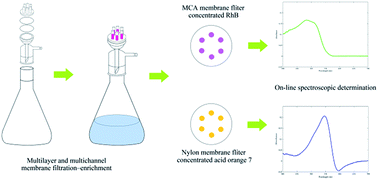Multilayer and multichannel membrane filtration for separation and preconcentration of trace analytes and its application in spectral analysis
Abstract
Membrane filtration (microfiltration) as a solid-phase extraction technique with features of rapidity, simplicity of operation, low cost, and high enrichment efficiency has received considerable attention and has been widely used for separating and enriching analytes from fluids. On the basis of our previous study, a very simple but effective mode of multilayer membrane filtration-enrichment process was introduced into the case of quantitative detecting of two or more analytes in mixture samples to achieve the target of separating and concentrating analytes simultaneously. A case study was carried out to assess this method utilizing the carcinogenic dyes rhodamine B (RhB) and acid orange 7 as model analytes. Under the optimal conditions, linearity of the calibration curve based on the Kubelka–Munk function was achieved in the concentration range of 3–30 μg L−1 with the correlation coefficients (R2) of 0.9982 and 0.9952 for RhB and acid orange 7, respectively. Good repeatability was achieved utilizing 30, 10 and 5 μg L−1 solutions with the relative standard deviations (RSDs) of 3.1–6.4% for RhB and 2.4–5.8% for acid orange 7. The presented method was successfully employed to simultaneously quantify RhB and acid orange 7 in soft drink and candy samples.


 Please wait while we load your content...
Please wait while we load your content...